Who Are You Guys, and Why Can’t
I Open My Store?
The following is an excerpt from a compilation of EMC stories
presented several years ago at a Seattle EMC Chapter meeting
by Patrick André of André Consulting, Inc. “A
new grocery store had been opened in St. Louis, MO. This new
“high-tech” (now normal) store included the installation
of 15 scanning checkout stands with customer enunciator panels.
A week before the big grand opening, store management turned
on the new checkout stands to verify their functionality.
The function tests carried on the rest of that day and into
the next. However, the next morning, a group of men walked
in carrying radios and red tags. The checkout stands were
red tagged and turned off. The men left. The late Chris Kendall
(CKC Laboratories) was called in as an EMC consultant to find
out what was happening and to fix the problem. Chris went
to work and found the problem right away. The enunciator panels
had a display driver at the bottom of the display. The connector
to the display was at the top of the display and there were
5 MHz data lines running around one side of the panel and
then returned on the other side of the panel. The men who
arrived were, of course, from the FCC. They were upset because
a local repeater was being jammed (at about 110 MHz). The
fix introduced by Chris was to tie a wire to the ground path
and lay the wire on top of the clock traces as an image return.
Once this was done, the interference problem went away, the
red tags were removed and the store opened. The lesson? Remember
Mary and her little lamb... everywhere the signal goes, its
ground is sure to follow.” |
Welcome New Chapter!
Victoria (Australia)
Please welcome the newly founded Victoria IEEE EMC Chapter in
Australia! The EMC Society Board of Directors, Chapters, and Members
welcome the new Chapter. The Chairman of the new Victoria IEEE
EMC Chapter in Australia is Malcolm Mulcare. He can be reached
at malmulcare@pacific.net.au
Austria
Over 80 people participated in the “4th Austrian IEEE EMC
Symposium” organized by the Austrian EMC Chapter together
with the Institute for Electronics of the Graz University of Technology
and the Austrian Electro- technical Association (OVE) in cooperation
with the Research Institute for Integrated Circuits of the Johannes
Kepler University Linz. The one-day event took place at the campus
of ARC Seibersdorf Research, which is the largest contract research
enterprise in Austria. It was sponsored by Würth Electronics,
Rohde & Schwarz, UEI and publish-industry publishing company.
At the Symposium, nine speakers presented their research activities
and talked about many different topics like nuclear electromagnetic
pulse, EMC at the chip-level, EMC problems caused by cables, anechoic
chamber validation, EMC filters, measurement uncertainties etc.
During the lunch break and after the presentations, the audience
had the opportunity to discuss and to visit a small exhibition.
Following the presentations, attendees were able to visit the
Seibersdorf EMC Test Lab. It was a great event and very much appreciated
by the attendees. More photographs of the “4th Austrian
IEEE EMC Symposium” can be found at our web page: www.smart-systems.at/Fachtagung2006.
In 2007, the Austrian IEEE EMC Symposium will take place at the
Graz University of Technology.
 |
| Participants of the Austrian EMC
Symposium 2006 await the beginning of one of the first technical
presentations. |
 |
| Participants of the Austrian EMC
Symposium 2006 enjoy the break in front of the building. |
 |
| Dr. Deutschmann and Dr. Winkler during
their talk at the Austrian EMC Symposium 2006. |
Central New England
On June 21, 2006 the Central New England Chapter of the EMC Society
sponsored a “Boston Tech Tour EMC Seminar” at the
Westford Regency Inn and Conference Center, Westford, Massachusetts.
The event was attended by over 60 technical professionals involved
in the EMC technology field. The half-day event consisted of a
three part technical seminar. The goal of the seminar presentations
was to provide practical information for the EMC engineer, designer
or technician to actually use on the job! Following the technical
seminar, a reception with the speakers was held at the hotel.
Participants were able to meet with the speakers and view hands
on demonstrations that were designed to “drive home”
the material presented. A door prize drawing was held at the conclusion
of the reception. Those who completed a survey form (provided)
at the end of the event received a ticket to enter the drawing
for door prizes. The first paper covered “Lab RF Cables,
Connectors, and Accessories Using eBay and a Test Receiver”
by Lee Hill of SILENT. Many EMC engineers and technicians have
and are familiar with using a spectrum analyzer with a tracking
generator. This presentation gave a hands-on demonstration of
how to create a very sensitive, low cost measurement system for
characterizing the performance of RF devices found in most EMC
troubleshooting and test laboratories. There was a short tutorial
on the advantages, disadvantages and best use of insertion loss
and return loss measurements. Lee Hill is Founding Partner of
SILENT, a private consulting firm established in 1992 that specializes
in design for EMC, EMC troubleshooting, RF design and training.
Previously Lee was Principal EMC and Systems Engineer at Digital
Equipment Corporation’s Workstation Systems Engineering
Group in Palo Alto. Lee has over 20 years of experience in the
EM design and retrofit of complex electronic systems. He has been
teaching short courses on EMC design and troubleshooting for 13
years. Lee received the Master of Science Degree in Electrical
Engineering and Electromagnetics with highest honors from the
University of Missouri-Rolla (UMR). The next speaker was James
Young of Rohde & Schwarz who presented a paper entitled, “Improving
the Accuracy of EMI Measurements.” Topics covered by James’
paper included “The Spectrum Analyzer versus The EMI Receiver
(Advantages and Disadvantages).” He also covered the problems
and benefits of using low noise amplifiers for increased sensitivity.
James Young is the sales and marketing manager for Rohde &
Schwarz EMI products in the Americas. His engineering background
includes system, circuit, ASIC and FPGA design for various communication
products. He has also held product management and marketing positions
with Cadence (Tality) in San Jose, CA, Parker Vision in Jacksonville,
FL and Signal Space Design in Salt Lake City, UT. He holds a BSEET
from Weber State University and an MBA from the University of
Phoenix. The third speaker, Zhong Chen of ETS-Lindgren, presented
“Applications of Field Probes for Efficient EMC Measurements.”
This presentation covered the important parameters of electromagnetic
field probes for effective EMC measurements, how to select field
probes for the specific applications, using calibrations to improve
measurement uncertainties, and how to avoid pitfalls in radiated
immunity measurements. Zhong Chen is a senior principal design
engineer at ETS-Lindgren in the field sensing devices group. He
received his M.S.E.E. degree in electromagnetics from Ohio State
University in Columbus, Ohio.
 |
| An audience of more than 60 in attendance
enjoys the June EMC Tech Tour hosted by the Central New England
Chapter. |
 |
| James Young of Rohde & Schwarz
presenting his paper to the Central New England Chapter in
June. |
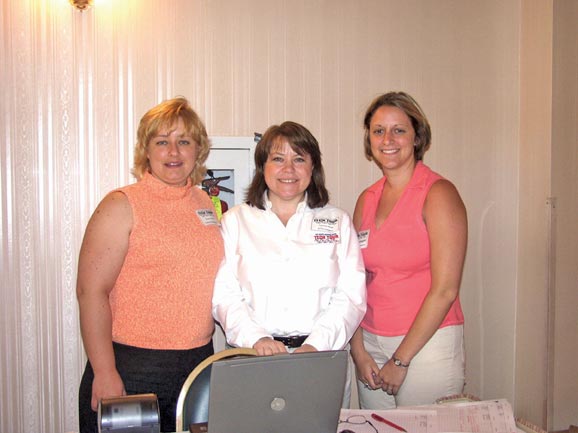 |
| Sharon Smith (left) and Alexis Harrington
(right) from Conformity Magazine, and Tammy Hojat of ETS-Lindgren
(center) enjoy a few moments together at the June EMC Tech
Tour hosted by ETS-Lindgren, Rohde & Schwarz, and Conformity
Magazine for the Central New England Chapter. |
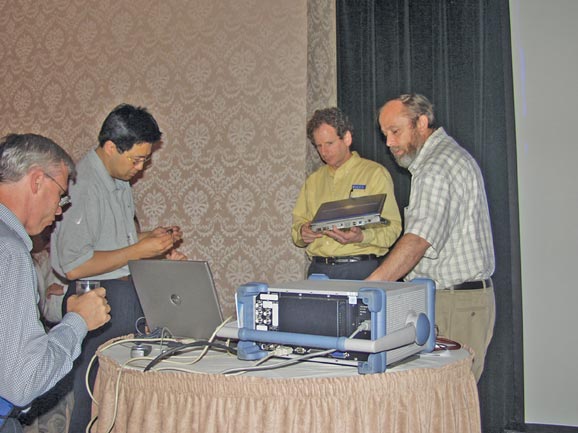 |
| Lee Hill of SILENT (second from right)
provided a demonstration for the Central New England Chapter
following his presentation at the June Tech Tour. |
 |
| Zhong Chen of ETS-Lindgren presenting
his paper at the June Tech Tour in Boston. |
Chicago
In February, Bob Hofmann of Hofmann EMC Engineering presented
the status of ANSI IEEE C63.5-2006, which is the standard for
calibration of EMC antennas. His presentation covered the various
calibration methods, i.e. standard site method, reference antenna
method, and equivalent capacitance substitution method. He also
presented information on the most recent document revision and
the significance of the updates to EMC testing. In March, Roy
Leventhal of Leventhal Design & Communications spoke to the
Chapter attendees on EMC simulation through computer modeling.
Roy gave a step-by-step review of how various levels of simplification
are applied to transistor level physical models. He also demonstrated
how to achieve the best speed versus accuracy trade-off of simplicity
versus detail. The session concluded with a brief introduction
to the Cadence Design Systems macro-modeling templates. The April
meeting featured a presentation on Motorola’s Improved Broadband
Over Power Lines (BPL). Dick Illman of Motorola’s Enterprise
Mobility Solutions gave the technical presentation. Mr. Illman
described Motorola’s BPL enhancement, which reduces RF interference
to and from infrastructure and does not use the medium voltage
power lines as a radiating element. He identified the EMC issues
and measurements associated with the implementation of BPL. The
Chicago Chapter concluded its technical presentation season with
the Annual Chicago EMC Mini-Symposium. This was the 8th consecutive
year of the event and featured keynote lecturer Lee Hill of Silent.
Lee’s topic, “What Your Mother Never Told You About
Ferrites” was fast paced and informative for the audience,
which included over 75 attendees. The Mini-Symposium also featured
technical presentations from Tom Braxton who lectured on Fundamentals
of EMC and Mr. Jason Smith of AR Worldwide who presented the changes
in the immunity standard IEC 61000-4-3. Lastly, Jack Black of
DLS Electronics spoke to attendees on RoHS compliance and Ray
Klouda of Elite Electronic Engineering concluded the event with
an open forum discussion on common EMC measurement problems. The
Chicago Chapter proudly announced it has established an annual
scholarship funded by the honorarium it received as the host committee
for the 2005 IEEE EMC Symposium. The scholarship will be awarded
to a student selected from an electrical engineering or physics
program that is a member of the IEEE and has demonstrated an interest
in EMC or signal integrity. Finally, at the Mini-Symposium the
Chicago members recognized Ms. Carla Robinson for her many years
of enthusiastic dedication to the Chapter. Carla recently announced
her plans for marriage, which will also include relocation to
southern Illinois. We are all extremely happy for her but will
certainly miss her cheerful spirit and friendship.
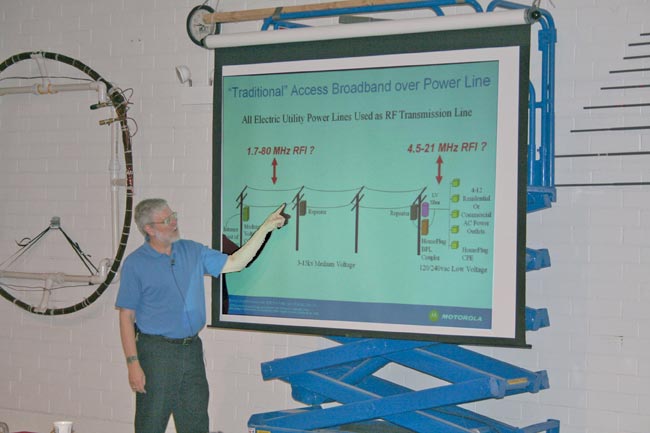 |
| Dick Illman of Motorola during his
April presentation on advancements in BPL to the Chicago Chapter. |
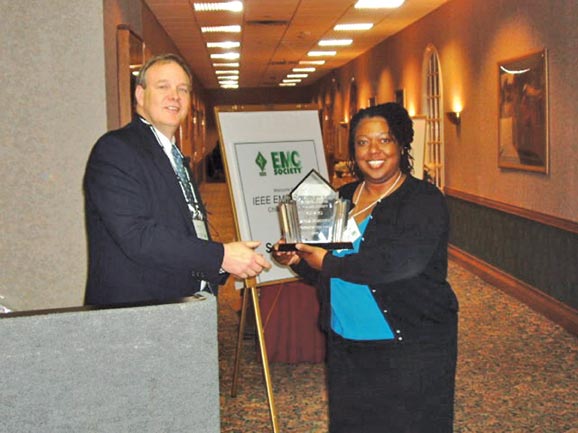 |
| Jack Black of DLS Electronics recognizes
Carla Robinson for her outstanding service to the Chicago
Chapter at their recent Mini-Symposium. |
Germany
On May 16, the German Chapter welcomed the participants of the
Region 8 workshop on computational electromagnetic (CEM) computer
modeling at the Hamburg University of Technology, Hamburg, Germany.
The workshop included a number of well-known speakers and the
President of the EMC Society. The attendees, which included 35
scientists and engineers from industry, government agencies, research
institutes and academics were welcomed by the technical program
chair of the workshop, Frank Sabath. In his opening address, Mr.
Sabath told the workshop participants that the IEEE German EMC
Chapter wanted to express its gratitude to Herman Singer and to
honor his technical achievement. Herman Singer has investigated
CEM computational methods for three decades. During this time
and due to his outstanding dedication to his profession as professor
and engineer, he was able to establish his institute as one of
the top competence centers on CEM computer modeling in Europe.
All six speakers delivered presentations of interest and high
quality. The topics spanned from a survey of CEM modeling and
new developments in the area of CEM modeling to validation techniques
and standardization efforts. The participants provided immediate
feed back with a large number of questions and discussions. Even
during coffee breaks and lunch time, technical discussions did
not stop. As a result, all participants agreed that the technical
content was well worth the effort.
 |
| Host and speakers of the Region 8
workshop on CEM computer modeling, from left: Herman Singer,
Andy Drozd, Bruce Archambeault, Ulrich Jakobus, Heinz Brüns,
Marko Leone, and Frank Sabath. |
 |
| Attendees of the Region 8 workshop
on CEM computer modeling. |
 |
| Discussions at the German EMC workshop
continued during coffee breaks. |
 |
| Herman Singer gladly accepts good
wishes for his retirement. |
Malaysia
The IEEE AP/MTT/EMC Joint Chapter of Malaysia held a one-day training
on CST Microwave Studio Software, a specialist tool for 3D EM
simulation of high frequency problems. Dr. Linus Lau from CST
Malaysia conducted the training on June 1, 2006 at the Microwave
Technology Centre, Universiti Teknologi MARA, Shah Alam. There
were a total of 15 participants. The Malaysia Chapter will be
hosting the International RF and Microwave Conference (RFM2006)
12 – 14 September 2006 at the Palm Garden Hotel, Putrajaya,
Malaysia. RFM2006 is a biannual Chapter event aimed to provide
opportunities for researchers, engineers and industrialists working
in areas related to RF and microwave to present research results
and new findings. It also aims to foster a close academia-industry
relationship and serves as a platform to discuss areas of mutual
interest among attendees. More than 75 paper abstracts from 20
participating institutions and industries of 10 countries have
been received. Other planned events include a one-day tutorial,
conference opening ceremony, plenary session, technical sessions
and industrial exhibition. Details of the conference can be obtained
from the conference website at www.uitm.edu.my/mtc/.
Phoenix
Glen Gassaway reports that the featured speaker in March was Dr.
Franz Schlagenhaufer of the Western Australian Telecommunications
Research Institute (WATRI). The meeting began with the customary
social hour starting at 6 pm. After attendees had their fill of
Garcia’s great Mexican food, Harry Gaul, the Chapter chairman,
called the meeting to order at 7:00 pm. It was immediately apparent
that they had another excellent turn out, with over 20 persons
attending, including one person from Tucson. Dr. Schlagenhaufer
told the Phoenix Chapter that numerical field simulation is a
useful tool for achieving electromagnetic compatibility on a system
level. Numerical field simulation results may not have extreme
accuracy on complex system models (as may be necessary for precise
RF models), but generally EMC problems do not require that level
of accuracy. During the simulation process, it is important to
neglect as many unimportant details as possible to speed up the
simulation, while keeping essential details. Therefore, performing
meaningful simulations can be somewhat of an art form. System
simulations are not meant to replace actual measurements, but
are very useful in providing problem insight, supporting problem
solving, and predicting the responses of design modifications.
Situations when numerical simulations should be performed include:
a) when the product is not available (such as shipboard antenna
structures), b) when controlled variations of parameters are not
possible (such as lightning strikes on transmission lines) and
c) when the physical value of interest is not easily obtainable
(such as the inductance value of complex structures). Dr. Schlagenhaufer’s
presentation addressed the five basic steps of a typical simulation
procedure: Modeling, Meshing, Computation, Result Validation,
and Post-Processing Routines. Modeling includes transforming the
physical model into a mathematical one. It is important to simplify
and neglect non-essential parts of the physical model. It is important
to know if the modeling assumptions are reasonable, and if adequate
computer resources are available. Meshing includes converting
the model into something the computer can understand. Segment
sizes should be based on wavelength and structural discontinuities.
The program itself generally does computation. Presently available
software is usually very accurate, but the output is only as good
as the model. Before attempting the computation process, it is
important to estimate calculation time and computer resource requirements.
Result validation is often done by reviewing boundary conditions,
power budget, field and current distributions and the model’s
sensitivity of the variation of input data. Post-processing is
required to display the results in a meaningful manner. Perhaps
the best data display could be a set of observation points versus
frequency, an observation line, or an observation plane. Combinations
of these or other displays may also be meaningful. Dr. Schlagenhaufer
closed the presentation with the following remarks: When it comes
to field simulation for complex systems, some particularities
can be noted. The outcome from the simulations will, in most cases,
not be the final result, but rather the simulation results will
be the input data for further systems analysis. After the presentation,
Harry Gaul presented Dr. Schlagenhaufer with a beautiful Arizona
Highways Calendar for his efforts. The Phoenix Chapter thanks
Dr. Schlagenhaufer for a very interesting lecture! Information
on future meetings is available on the Phoenix EMC Chapter Web
site at https://www.ewh.ieee.org/r6/phoenix/phoenixemc/.
 |
| In his talk on electromagnetic modeling,
Dr. Franz Schlagenhaufer explains to the Phoenix Chapter the
need to increase the mesh density near edges where the current
is rapidly changing. |
 |
| Harry Gaul (right) presents Glen
Gassaway with an appreciation award from the Phoenix Section
for his contributions to the operation of the Phoenix EMC
Chapter in 2005. |
Pittsburgh
The second meeting of the newly formed Pittsburgh EMC Society
Chapter was held on Thursday, May 11 at the Westinghouse Energy
Center in Monroeville, PA. Michael Oliver, IEEE EMCS Chapter Chair
hosted the meeting. The meeting started with a social prior to
a technical presentation. We had the privilege of having Harry
Godlewski as our technical speaker; Harry is the Vice Chairman
of the IEEE EMC Chapter. The meeting had 15 attendees. Discussions
at the meeting encompassed the upcoming technical presentations
agenda and an introduction of Harry Godlewski. The technical presentation
by Mr. Godlewski titled “EMC: An Overview” presented
the historical origins and the driving interest in EMC. Reviews
of the impact of EMC engineering from component level, intra-system
to inter-systems were also discussed. In addition, various modes
of interference were presented. Methods and approaches available
for mitigation and prevention of electromagnetic interference
(EMI) were summarized. In conclusion, an overview of the various
guidance/compliance documents that are available and some field
examples of EMI investigation were presented. Mr. Godlewski, currently
employed by Nu-Metrics, has over two decades of experience with
RF systems, electromagnetic radiating systems, and electromagnetic
compatibility issues. His experience encompasses work through
and with firms involved in strictly commercial applications as
well as with defense systems. He holds a BSEE from the University
of Pittsburgh and an MSEE from Northeastern University in Massachusetts.
He is a professionally registered engineer and a Certified Electromagnetic
Compatibility Engineer (certified by the National Association
of Radio and Telecommunications Engineers).
 |
| Harry Godlewski during his May EMC
overview presentation to the newly formed Pittsburgh Chapter. |
 |
| Harry Godlewski (right) recieves
much deserved recognition and thanks for his May presentation
to the Pittburgh Chapter. |
Seattle
In May, CKC Laboratories sponsored a special afternoon session
with three excellent speakers. First to speak was Leo Makowski,
President of HV Technologies. Mr. Makowski spoke on the latest
lightning test requirements and test techniques. During the day,
Mr. Makowski was able to demonstrate HV Technologies Multiple
Burst / Multiple Stroke Lighting Test Equipment which was recently
installed at CKC Laboratories’ new Bothell, Washington facility.
Following Mr. Makowski, attendees were treated to an excellent
catered lunch, courtesy of CKC Laboratories. After the lunch break,
which included tours of CKC’s new test facilities, Mr. Ralph
Trefney of Science Works Company spoke on “How to Pass EMC
Testing: A Brief Guide to Avoiding the Common Causes of Failure.”
Mr. Trefney is a highly experienced, NARTE certified, independent
consultant in the Seattle area. With his extensive background
in commercial, aerospace, military, and RF electronics, Mr. Trefney’s
talk was filled with practical experience, common design errors,
and proper methods to avoid problems during testing. The final
speaker was Mr. Brent DeWitt. Mr. DeWitt is an independent consultant
in the Seattle area specializing in medical standards and design.
His talk, “At the Crossroads of Safety and Performance:
Future Paths for Medical EMC Standards,” was based on his
intimate knowledge of the subject. Mr. DeWitt represents the United
States on SC 62A WG-13, the committee that wrote and maintains
the Medical EMC Standard IEC 60601-1-2. In addition, Mr. DeWitt
serves as the vice chairman of the Seattle EMC Chapter. Attendees
at the special May Seattle meeting were also treated to a drawing
for three each, $100 gift certificates to Best Buy, courtesy of
Panashield, Inc. The happy and enthusiastic winners were Jim Robsen
of Zetron, Farzad Keshvadian of Boeing, and Holland Guldberg of
UASC.
 |
| Leo Makowski of HV Technologies gives
an excellent presentation on the latest lightning test requirements
and techniques to the Seattle Chapter in May. |
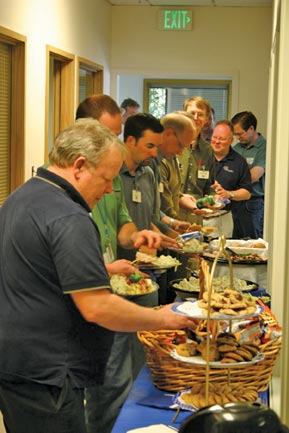 |
| Attendees at the Seattle May meeting
enjoy an excellent catered lunch, courtesy of CKC Laboratories. |
 |
| Many of those who attended the Seattle
May meeting enjoyed eating their lunch outdoors on CKC’s
covered loading dock. |
 |
| Ralph Trefney (far right) discusses
avoiding common EMI failures with an enthusiastic crowd at
Seattle’s May meeting. |
 |
| Brent DeWitt spoke at the Seattle
EMC Chapter “Triple-Header” half day meeting in
May. |
Southeast Michigan
On January 30-31, the Chapter held a two-day workshop on Automotive
EMC Standards at the University of Michigan at Dearborn’s
Fairlane Center. It was held immediately following the week-long
series of meetings of the ISO automotive EMC committee held at
the SAE headquarters in Troy, Michigan. As such, it attracted
attendance from all over the world. Poul Andersen started the
first day noting that the workshop would address automotive related
EMC topics in such standards issued by CISPR, ISO, and the SAE.
Agenda topics covered standards activity related to ESD, emissions,
immunity, transients, and alternative methods. There were also
presentations on integrated circuits (per IEC and SAE standards)
and hybrid GM/DCX EV testing. The “Big Three” were
represented with presentations by GM’s Don Seyerle, Ford’s
Keith Frazier, and DaimlerChrysler’s Terry North and Andrew
Shune. Nissan’s Hitoshi Tsukahara also presented. The workshop
concluded with presentations from various professional organizations
such as NARTE and A2LA. Phil Fanson addressed AEMCLRP accreditation
experiences. It had been two years since this standards workshop
had been held and all agreed the new developments were very interesting
to hear. “Electromagnetic Computational Modeling for Real-World
Engineering Problems” was the title of the brilliant presentation
by Dr. Bruce Archambeault for Southeastern Michigan’s EMC
Fest held on May 2. Dr. Archambeault went carefully over the various
computational methods used in evaluating electromagnetic conundrums.
Participants went home with valuable knowledge that could be used
in choosing new analysis packages. Over 80 people attended this
one-day colloquium and exhibition. For more information on the
activities of this very active Chapter, visit their website at
www.emcsociety.org.
 |
| Scott Lytle of Yazaki North America,
Kimball Williams of Denso International America Inc., Matt
Feusse of Yazaki North America, speaker Dr. Bruce Archambeault
of IBM, Dr. Candace Suriano of Suriano Solutions and Robert
Kado of DaimlerChrysler (from left) at the SE Michigan’s
annual EMC Fest event. |
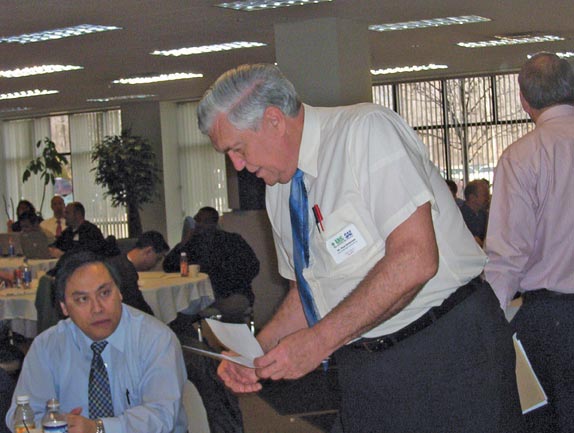 |
| Kin Moy (left) and Poul Andersen
get material ready for the start of a two-day workshop organized
by the SE Michigan Chapter on Automotive EMC Standards. |
 |
| Russ Carstensen of NARTE (left) prepares
his tabletop display as Kimball Williams of Denso International
America looks on. |
Washington DC/ Northern Virginia
Mike Violette of Washington Labs reports that on April 25, the
Chapter featured a “Tech Tour” half-day seminar hosted
by ETS-Lindgren, Rohde & Schwarz, and Conformity Magazine
at the Sheraton Columbia Hotel in Columbia, Maryland. Guest speakers
included leading industry experts, Blaise Corbett of the Naval
Surface Warfare Center, Dahlgren, Virginia, Vince Rodriguez of
ETS-Lindgren, and Vic Hudson of Rohde & Schwarz. Some 30 people
attended and enjoyed hearing the presentation titled “Reverberation
Chambers: A Statistical Approach For Conducting Cost-Effective
System Electromagnetic Vulnerability Assessments” by Mr.
Corbett. He explained that reverberation chambers are emerging
as an alternative test facility for EM/EMC measurements. Long
a main stay test technique in the automotive and military industries,
reverberation chambers are currently used for a wide range of
measurement applications such as radiated immunity of components
and large systems, radiated emissions, shielding characterizations
of cables, connectors and material, to name a few. Mr. Corbett
addressed these topics as well as reviewed EM measurements in
complex cavities and reverberation chambers. This was followed
by a presentation titled “Anechoic Chamber Solutions for
Antenna Pattern Measurements” by Vince Rodriguez. Dr. Rodriguez
introduced the user to antenna ranges, and concentrated on rectangular
and taper anechoic chambers for APM. Absorber technology, Quiet
Zone levels, and far field requirements were discussed as well
as the proper absorber treatment for both taper and rectangular
chambers. The final presentation was titled “Improving the
Accuracy of EMI Emissions Testing” by Vic Hudson, Rohde
& Schwarz. Mr. Hudson explained why EMI measurements require
a different approach than other types of general RF tests. In
EMI, engineers never quite know what signals may be present. Knowing
the strengths and weaknesses of the tools being used is vital.
Two instruments are used for EMI testing, spectrum analyzers and
test receivers. Each requires a different approach to the test,
and each has advantages and disadvantages. Mr. Hudson’s
presentation explored and compared both instruments. Other related
topics presented included “Common Misunderstandings and
Mistakes” when performing and designing test systems for
EMI measurements. The seminar concluded with a reception with
the speakers where refreshments were served and a door prize drawing
was held. This provided a great opportunity to network with the
speakers and view demonstrations of the material presented. On
June 22, the Washington DC/Northern Virginia Chapter held its
Chapter meeting at the Bell Labs Network Reliability and Security
Office (*wow*) on New York Avenue in Washington DC. “ZAP!
Washington Gets Hit By Lightning. No Lawyers Reported as Injured!”
Leo Makowski, President of HV Technologies, provided a detailed
look at the new RTCA DO-160 Lightning Testing requirements. Improved
characterization of multi-strike and multi-burst lightning phenomena
have led to a better understanding of the test conditions necessary
to simulate these events. The box-level, or Field Replaceable
Unit (FRU), testing specify pin and bulk current injection requirements.
The objective is to improve subsystem reliability. Testing to
these lightning events is increasingly necessary as more airframe
manufacturers move to composite airframe structures in the quest
to decrease weight and improve fuel efficiency. In the past, the
aluminum skin of airplanes provided an excellent Faraday shield
to lightning strikes; while airframe designers employ metalization
in composite structures to improve conductivity and maintain shielding,
two factors increase potential system vulnerabilities: an overall
lower conductivity increases “leakage” through aircraft
skin and more flight electronics, wiring, and cabling increase
the number of potential vulnerabilities. To mitigate threats and
effectively meet the design challenges, an understanding of the
waveforms and the test methodologies is necessary. Mr. Makowski
provided the gathered group with a detailed explanation of the
evolving requirements as well as test solutions for meeting the
DO-160 lightning requirements. As the thunderstorm season revs
up, anyone who flies should be grateful for the diligent efforts
of those involved in the design, testing, and reliability of those
funny boxes with wires that are buried under the skin of every
airplane. The meeting was hosted by the Bell Labs NRSO, which
features a state-of-the-art conference/multimedia center. Lucent
graciously provided the venue as part of its corporate outreach
program aimed at supporting technical associations and non-profit
organizations. The Chapter appreciates their generous hosting.
EMC
 |
| Allison Black from NRSO welcomes
Leo Makowski of HV Technologies to the June meeting of the
Washington DC/Northern Virginia Chapter. |
 |
| Bell Labs NRSO provided a state of
the art meeting facility for the Washington DC/Northern Virginia
Chapter. |
 |
| Guillermo Warley, Greg Snyder of
Washington Labs, and Tom Boughner of EMC Technologies (from
left) enjoy the June meeting of the Washington DC/Northern
Virginia Chapter. |
 |
| Happy attendees at the Washington
DC/Northern Virginia Chapter meeting. |
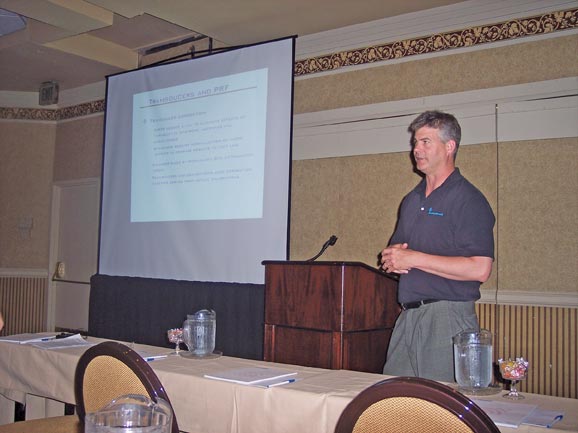 |
| Vic Hudson of Rohde & Schwarz
presented “Improving the Accuracy of EMI Emissions Testing”
at the April meeting of the Washington DC/Northern Virginia
Chapter. |
 |
| Dr. Vince Rodriguez of ETS-Lindgren
presented “Anechoic Chamber Solutions for Antenna Pattern
Measurements” at the Washington DC/Northern Virginia
Chapter half day Tech Tour seminar in April. |
 |
| Blaise Corbett of the Naval Surface
Warfare Center explained that reverberation chambers are emerging
as an alternative test facility for EM/EMC measurements during
his presentation to the Washington DC/Northern Virginia Chapter. |
 |
| A reception with the speakers was
held following the half day April Tech Tour in Columbia, Maryland,
and concluded with a few raffle drawings. Sharon Smith of
Conformity Magazine presented a raffle prize to lucky Len
Knight of MET Laboratories. |
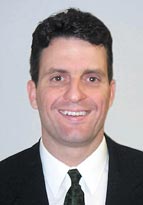 Chapter
Chatter
Chapter
Chatter